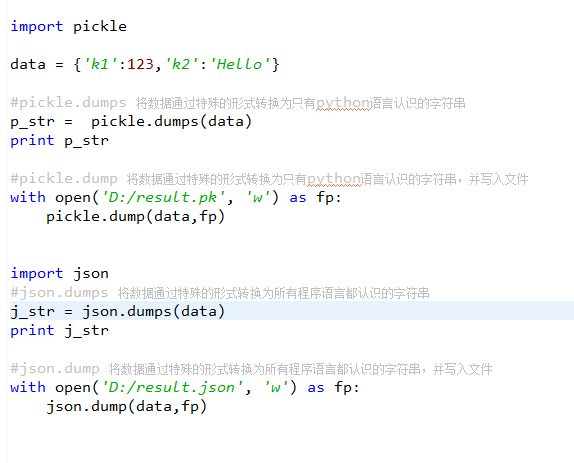day6 常用标准模块
一、os
用于提供系统级别的操作
os.getcwd() 获取当前工作目录,即当前python脚本工作的目录路径 os.chdir("dirname") 改变当前脚本工作目录;相当于shell下cd os.curdir 返回当前目录: ('.') os.pardir 获取当前目录的父目录字符串名:('..') os.makedirs('dirname1/dirname2') 可生成多层递归目录 os.removedirs('dirname1') 若目录为空,则删除,并递归到上一级目录,如若也为空,则删除,依此类推 os.mkdir('dirname') 生成单级目录;相当于shell中mkdir dirname os.rmdir('dirname') 删除单级空目录,若目录不为空则无法删除,报错;相当于shell中rmdir dirname os.listdir('dirname') 列出指定目录下的所有文件和子目录,包括隐藏文件,并以列表方式打印 os.remove() 删除一个文件 os.rename("oldname","newname") 重命名文件/目录 os.stat('path/filename') 获取文件/目录信息 os.sep 输出操作系统特定的路径分隔符,win下为"\\",Linux下为"/" os.linesep 输出当前平台使用的行终止符,win下为"\t\n",Linux下为"\n" os.pathsep 输出用于分割文件路径的字符串 os.name 输出字符串指示当前使用平台。win->'nt'; Linux->'posix' os.system("bash command") 运行shell命令,直接显示 os.environ 获取系统环境变量 os.path.abspath(path) 返回path规范化的绝对路径 os.path.split(path) 将path分割成目录和文件名二元组返回 os.path.dirname(path) 返回path的目录。其实就是os.path.split(path)的第一个元素 os.path.basename(path) 返回path最后的文件名。如何path以/或\结尾,那么就会返回空值。即os.path.split(path)的第二个元素 os.path.exists(path) 如果path存在,返回True;如果path不存在,返回False os.path.isabs(path) 如果path是绝对路径,返回True os.path.isfile(path) 如果path是一个存在的文件,返回True。否则返回False os.path.isdir(path) 如果path是一个存在的目录,则返回True。否则返回False os.path.join(path1[, path2[, ...]]) 将多个路径组合后返回,第一个绝对路径之前的参数将被忽略 os.path.getatime(path) 返回path所指向的文件或者目录的最后存取时间 os.path.getmtime(path) 返回path所指向的文件或者目录的最后修改时间
二、sys
用于提供对解释器相关的操作
sys.argv 命令行参数List,第一个元素是程序本身路径 sys.exit(n) 退出程序,正常退出时exit(0) sys.version 获取Python解释程序的版本信息 sys.maxint 最大的Int值 sys.path 返回模块的搜索路径,初始化时使用PYTHONPATH环境变量的值 sys.platform 返回操作系统平台名称 sys.stdout.write('please:') val = sys.stdin.readline()[:-1]
三、time
时间相关的操作,时间有三种表示方式:
- 时间戳 1970年1月1日之后的秒,即:time.time()
- 格式化的字符串 2014-11-11 11:11, 即:time.strftime('%Y-%m-%d')
- 结构化时间 元组包含了:年、日、星期等... time.struct_time 即:time.localtime()
import time #时间戳转字符串格式 a = time.time() print(a) #打印时间戳 b = time.localtime(a) #把时间戳转换成时间对象 元组的形式 print(b) c = time.strftime("%Y-%m-%d %H:%M:%S",b) #格式化时间 把事件对象转化成格式化的字符串 print(c) #字符串时间转化为时间戳 d = time.strptime("2016-11-14 09:37:26","%Y-%m-%d %H:%M:%S") print(d) e = time.mktime(d) print(e) #时间加减 import datetime print(datetime.datetime.now()) #返回 2016-08-19 12:47:03.941925 print(datetime.date.fromtimestamp(time.time()) ) # 时间戳直接转成日期格式 2016-08-19 print(datetime.datetime.now() ) print(datetime.datetime.now() + datetime.timedelta(3)) #当前时间+3天 print(datetime.datetime.now() + datetime.timedelta(-3)) #当前时间-3天 print(datetime.datetime.now() + datetime.timedelta(hours=3)) #当前时间+3小时 print(datetime.datetime.now() + datetime.timedelta(minutes=30)) #当前时间+30分 c_time = datetime.datetime.now() print(c_time.replace(minute=3,hour=2)) #时间替换
四、random
随机数
import random import string print( random.randint(1,2)) #包含1和2 print(random.randrange(1,3)) #1和2 会出现,3不会出现
#随机生成验证码或密码 str_source = string.ascii_letters + string.digits suji = random.sample(str_source,8) print(suji) print("".join(suji))
随机验证码实例:
import random checkcode = '' for i in range(4): current = random.randrange(0,4) if current != i: temp = chr(random.randint(65,90)) else: temp = random.randint(0,9) checkcode += str(temp) print checkcode
五、shutil
高级的 文件、文件夹、压缩包 处理模块
shutil.copyfileobj(fsrc, fdst[, length])
将文件内容拷贝到另一个文件中,可以部分内容
f = open("example.log") f2 = open("example_new.log","w") shutil.copyfileobj(f,f2)
shutil.copyfile(src, dst)
拷贝文件
shutil.copyfile("example_new.log","example_new2.log")
shutil.copymode(src, dst)
仅拷贝权限。内容、组、用户均不变
shutil.copymode("example_new.log","example_new2.log")
shutil.copystat(src, dst)
拷贝状态的信息,包括:mode bits, atime, mtime, flags
shutil.copystat("example_new.log","example_new2.log")
shutil.copytree(src, dst, symlinks=False, ignore=None)
递归的去拷贝文件,并且过滤文件夹和文件
shutil.copytree("C:\\Users\Administrator\s16\day5", "C:\\Users\Administrator\s16\day6\Test", ignore=shutil.ignore_patterns('atm', '*.log'))
shutil.rmtree(path[, ignore_errors[, onerror]])
递归的去删除文件
shutil.rmtree("C:\\Users\Administrator\s16\day6\Test")
shutil.move(src, dst)
递归的去移动文件
shutil.rmtree("C:\\Users\Administrator\s16\day6\Test")
shutil.make_archive(base_name, format,...)
创建压缩包并返回文件路径,例如:zip、tar
hutil.make_archive("day5","zip","C:\\Users\Administrator\s16\day5")
打包和解压缩包
打包:
import zipfile z = zipfile.ZipFile('ziptest3.zip', 'w') z.write("C:\\Users\Administrator\s16\day5\\access.log.2",arcname="access.log.2") z.write("C:\\Users\Administrator\s16\day5\\access.log.1",arcname="access.log.1") z.write("example_new.log") z.write("day5.zip") z.close()
解压:
import zipfile tar = tarfile.open('your.tar','r') tar.extractall() # 可设置解压地址 tar.close()
六、执行系统命令
执行系统命令
可以执行shell命令的相关模块和函数有:
- os.system
- os.spawn*
- os.popen* --废弃
- popen2.* --废弃
- commands.* --废弃,3.x中被移除
call
执行命令,返回状态码
ret = subprocess.call(["ls", "-l"], shell=False) ret = subprocess.call("ls -l", shell=True)
shell = True ,允许 shell 命令是字符串形式
check_call
执行命令,如果执行状态码是 0 ,则返回0,否则抛异常
subprocess.check_call(["ls", "-l"]) subprocess.check_call("exit 1", shell=True)
check_output
执行命令,如果状态码是 0 ,则返回执行结果,否则抛异常
subprocess.check_output(["echo", "Hello World!"]) subprocess.check_output("exit 1", shell=True)
subprocess.Popen(...)
用于执行复杂的系统命令
参数:
- args:shell命令,可以是字符串或者序列类型(如:list,元组)
- bufsize:指定缓冲。0 无缓冲,1 行缓冲,其他 缓冲区大小,负值 系统缓冲
- stdin, stdout, stderr:分别表示程序的标准输入、输出、错误句柄
- preexec_fn:只在Unix平台下有效,用于指定一个可执行对象(callable object),它将在子进程运行之前被调用
- close_sfs:在windows平台下,如果close_fds被设置为True,则新创建的子进程将不会继承父进程的输入、输出、错误管道。
所以不能将close_fds设置为True同时重定向子进程的标准输入、输出与错误(stdin, stdout, stderr)。 - shell:同上
- cwd:用于设置子进程的当前目录
- env:用于指定子进程的环境变量。如果env = None,子进程的环境变量将从父进程中继承。
- universal_newlines:不同系统的换行符不同,True -> 同意使用 \n
- startupinfo与createionflags只在windows下有效
将被传递给底层的CreateProcess()函数,用于设置子进程的一些属性,如:主窗口的外观,进程的优先级等等
执行普通命令:
import subprocess ret1 = subprocess.Popen(["mkdir","t1"]) ret2 = subprocess.Popen("mkdir t2", shell=True)
七、subprocess
执行外部命令
subprocess.run("df") ###执行命令 subprocess.run(["df", "-h"]) ###执行带参数命令 subprocess.run("df -h | grep /dev/sda3", shell=True) ###执行shell命令,只有返回状态 call() ###执行命令,返回状态0 or 非0 check_call() ###执行命令,如果结果为0返回,否则抛出异常 ###接收字符串格式命令,返回元组形式,第1个元素是执行状态,第2个是命令结果 subprocess.getstatusoutput("df -h | grep /dev/sda3") (0, '/dev/sda3 519G 3.2G 489G 1% /') ###接收字符串格式命令,并返回结果 subprocess.getoutput("df -h | grep /dev/sda3") '/dev/sda3 519G 3.2G 489G 1% /' ###执行命令,并返回结果,注意是返回结果,不是打印,下例结果返回给res res = subprocess.check_output("df -h | grep /dev/sda3", shell=True) >>> res b'/dev/sda3 519G 3.2G 489G 1% /\n' ###上面那些方法,底层都是封装的subprocess.Popen p = subprocess.Popen("df -h | grep /dev/sda3", shell=True, stdout=subprocess.PIPE) p.stdout.read() b'/dev/sda3 519G 3.2G 489G 1% /\n' ###检查子进程是否已终止。返回returnCode poll() ###等待子进程终止。返回returnCode属性 wait() terminate() 杀掉所启动进程 communicate() 等待任务结束 stdin 标准输入 stdout 标准输出 stderr 标准错误 可用参数: args:shell命令,可以是字符串或者序列类型(如:list,元组) bufsize:指定缓冲。0 无缓冲,1 行缓冲,其他 缓冲区大小,负值 系统缓冲 stdin, stdout, stderr:分别表示程序的标准输入、输出、错误句柄 preexec_fn:只在Unix平台下有效,用于指定一个可执行对象(callable object),它将在子进程运行之前被调用 close_sfs:在windows平台下,如果close_fds被设置为True,则新创建的子进程将不会继承父进程的输入、输出、错误管道。 所以不能将close_fds设置为True同时重定向子进程的标准输入、输出与错误(stdin, stdout, stderr)。 shell:同上 cwd:用于设置子进程的当前目录 env:用于指定子进程的环境变量。如果env = None,子进程的环境变量将从父进程中继承。 universal_newlines:不同系统的换行符不同,True -> 同意使用 \n startupinfo与createionflags只在windows下有效 将被传递给底层的CreateProcess()函数,用于设置子进程的一些属性,如:主窗口的外观,进程的优先级等等
八、hashlib
用于加密相关的操作,代替了md5模块和sha模块,主要提供 SHA1, SHA224, SHA256, SHA384, SHA512 ,MD5 算法
import hashlib # ######## md5 ######## hash = hashlib.md5() hash.update('admin') print hash.hexdigest() # ######## sha1 ######## hash = hashlib.sha1() hash.update('admin') print hash.hexdigest() # ######## sha256 ######## hash = hashlib.sha256() hash.update('admin') print hash.hexdigest() # ######## sha384 ######## hash = hashlib.sha384() hash.update('admin') print hash.hexdigest() # ######## sha512 ######## hash = hashlib.sha512() hash.update('admin') print hash.hexdigest()
以上加密算法虽然依然非常厉害,但时候存在缺陷,即:通过撞库可以反解。所以,有必要对加密算法中添加自定义key再来做加密
九、json 和 pickle
用于序列化的两个模块
- json,用于字符串 和 python数据类型间进行转换
- pickle,用于python特有的类型 和 python的数据类型间进行转换
Json模块提供了四个功能:dumps、dump、loads、load
pickle模块提供了四个功能:dumps、dump、loads、load

十、configparser
对特定配置文件进行操作
# 注释1 ; 注释2 [section1] k1 = v1 k2:v2 [section2] k1 = v1
import ConfigParser config = ConfigParser.ConfigParser() config.read('i.cfg') # ########## 读 ########## #secs = config.sections() #print secs #options = config.options('group2') #print options #item_list = config.items('group2') #print item_list #val = config.get('group1','key') #val = config.getint('group1','key') # ########## 改写 ########## #sec = config.remove_section('group1') #config.write(open('i.cfg', "w")) #sec = config.has_section('wupeiqi') #sec = config.add_section('wupeiqi') #config.write(open('i.cfg', "w")) #config.set('group2','k1',11111) #config.write(open('i.cfg', "w")) #config.remove_option('group2','age') #config.write(open('i.cfg', "w"))
十一、logging
用于便捷记录日志且线程安全的模块
import logging logging.basicConfig(filename='log.log', format='%(asctime)s - %(name)s - %(levelname)s -%(module)s: %(message)s', datefmt='%Y-%m-%d %H:%M:%S %p', level=10) logging.debug('debug') logging.info('info') logging.warning('warning') logging.error('error') logging.critical('critical') logging.log(10,'log')
对于等级:
CRITICAL = 50 FATAL = CRITICAL ERROR = 40 WARNING = 30 WARN = WARNING INFO = 20 DEBUG = 10 NOTSET = 0
只有大于当前日志等级的操作才会被记录。
十二、re
re模块用于对python的正则表达式的操作
字符:
. 匹配除换行符以外的任意字符
\w 匹配字母或数字或下划线或汉字
\s 匹配任意的空白符
\d 匹配数字
\b 匹配单词的开始或结束
^ 匹配字符串的开始
$ 匹配字符串的结束
次数:
* 重复零次或更多次
+ 重复一次或更多次
? 重复零次或一次
{n} 重复n次
{n,} 重复n次或更多次
{n,m} 重复n到m次
IP: ^(25[0-5]|2[0-4]\d|[0-1]?\d?\d)(\.(25[0-5]|2[0-4]\d|[0-1]?\d?\d)){3}$ 手机号: ^1[3|4|5|8][0-9]\d{8}$
1、match(pattern, string, flags=0)
从起始位置开始根据模型去字符串中匹配指定内容,匹配单个
- 正则表达式
- 要匹配的字符串
- 标志位,用于控制正则表达式的匹配方式
re.match("^a", "alex li") re.match("^a.", "alex li")
2、search(pattern, string, flags=0)
根据模型去字符串中匹配指定内容,匹配单个
re.search("i$", "alex li") re.search("a*", "aaaalex li")
3、findall(pattern, string, flags=0)
上述两中方式均用于匹配单值,即:只能匹配字符串中的一个,如果想要匹配到字符串中所有符合条件的元素,则需要使用 findall。
re.findall("[a-zA-Z]+", "130435sd-fsd_f19900213x")
4、sub(pattern, repl, string, count=0, flags=0)
用于替换匹配的字符串
re.sub("\d{4}", "1995", "i was born in 1982-05-20") #替换全部 re.sub("\d{4}", "1995", "i was born in 1982-05-20 jiafei is in 1920")
5、split(pattern, string, maxsplit=0, flags=0)
根据指定匹配进行分组
#根据.进行分组 re.split("\W+", "192.168.1.55")
最常用的匹配语法:
re.match 从头开始匹配(一般不用)
re.search 匹配包含
re.findall 把所有匹配到的字符放到以列表中的元素返回
re.splitall 以匹配到的字符当做列表分隔符
re.sub 匹配字符并替换



